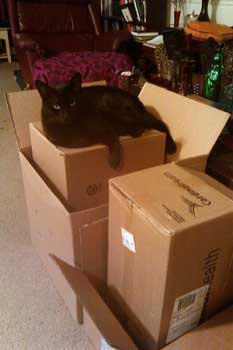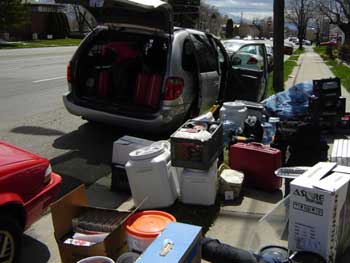Moving With Cat In Tow
Moving with cat in tow can be a worrying time with you wondering if they will run away or be stressed out.
Well moving homes is a stressful time for all concerned, including your feline friend. After all he will find himself in unfamiliar territory with lots of strange smells and wondering what on earth has happened.
It’s at times like this I wish they could understand English, so you can explain to them what is going on and not feel like a total villain by taking them away from everything they know.
The best we can do when moving with cat in tow is to make the whole experience as smooth and un-scary as possible.
Planning Ahead
So the house is sold and you have a moving date, you’ve booked the removals van and notified the authorities of your new address. But hang on a minute, what about the cat? What’s going to happen to them on the day of moving?
It’s best to decide in advance on how you are going to move your cat. There are two options open to you, board them in a cattery for a few days or take them with you on the day. Both have their merits but they both also have their downfalls.

Boarding in a cattery:
- Can you afford to pay the bill?
- Are your cat’s vaccinations up to date?
- Is your cat happy to go to a cattery or do they become stressed?
- Booking must be carried out well in advance.
- How close is the cattery to the new home?
Taking them with you on the day:
- Will you have the time to cater to their needs on the day?
- Do you have a suitable carrier that will be comfortable to be in all day?
- How will you keep your cat safe at the new home on the day of moving amongst all the chaos?
Choosing to board your cat for a few days will mean that you will not have to worry about them while you move.
Moving With Cat On The Day
This option will require more planning and there are no hard and fast rules on how this is best done, but here is a general guide:
- Empty a room in your current house a few days before moving – keep your cat in this room for those days with his bed, toys, litter tray, you may also want to feed him in there as well. This will give them time to get used to being confined for a while and this will also mean that on the day they will be kept safe in a locked room.

- Allocate a room in your new home which you will put your cat in on the day of moving. This room should also be kept locked on the day so that no accidental escapes happen.
- On the day of moving, feed your cat early with a small meal. This will help reduce any travel sickness later. Make sure the room is locked until you are ready to leave.
- The last thing to do before leaving your house is to move your cat. Pop them in their carrier with a comforting blanket. By leaving them till the very last will help to reduce the stress and also keep the trip as short as possible.
See travelling with your cat for tips for the journey.
- Once at the new home, place your cat in the allocated room with all their belongings. Feed them and make sure they have a litter tray available. It may also be a good idea to leave an item of clothing that smells of you in the room. This will help to comfort the cat while they are left alone in their new environment. Make sure the door is locked.
- Leave your cat in this room for a few days if possible as it can sometimes be a little overwhelming to have a whole house to explore at once. It will also allow you to sort the house out without fear of your cat getting outside just yet.

One of the major worries an owner has when moving with cat in tow is what will happen when they first venture outside their new home. There are never any guarantees that a cat will not decide to try and find his way back home, but you can reduce this happening.
Try and keep your cat inside for the first three weeks. This is not always possible and some cats adjust to their new surroundings much quicker than others. Only you as an owner will recognise if your cat is relaxed enough in the new home to allow them to go outside for the first time.
Let them out just before meal times, and then you can call them back with their favourite food.
Go outside with your cat and stay with them for a while. This will help your cat feel secure. If your cat doesn’t want to follow you out, do not force them to go.
Leave the door open so that your cat can return to the house when they want to. It might be a bit scary out there at first.
Keep the first few times they go out short. This will build up the bond to the new home.
Always make sure your cat is wearing a name and address collar and is microchipped before letting them out.
Moving With Cat Abroad.
Moving with cat abroad requires a whole lot more forward planning and preparation and I’m afraid cost. So if this is something you are considering, here are a few pointers on what needs to be done:
You will need to contact the ministry of agriculture, fisheries and food (MAFF) in the U.K, or the department of agriculture in the US to notify them of your move and to apply for an export licence. This should be done at least six weeks before moving with cat.
Find out what vaccinations are required for the specific country you are moving to and arrange for these to be carried out by your vet. Do this also at least six weeks in advance as some vaccinations cannot be given all at the same time, or need to be carried out a certain period of time before export.
Find an airline willing to export your cat. They will also inform you of all the paperwork that is required prior to the trip. This is important because without the right paperwork at your destination you could find your cat confined to quarantine for many months or even sent back home.
If you are moving with cat to the UK a mandatory six-month quarantine (this is under review) is required even if your cat has been vaccinated, so the cost of this stay and the affects on your cat must be considered.
Top of this Moving With Cat Page
I'd love to hear what you think of this page or my site. Let me know if you like what you have read or if it has helped you with a problem.
It's easy to do just leave a comment in the box below and click the like / share or +1 to let others know about my site. Thank You It really is most appreciated.






New! Comments
Have your say about what you just read! Leave me a comment in the box below.